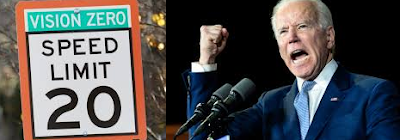President Joe Biden on Monday signed into law a sprawling transportation authorization bill that includes, for the first time ever, explicit federal funding support for speed cameras. The one-paragraph provision tucked into a 1039-page bill represents a major win for the photo enforcement industry, which will be the beneficiary of a share of the $2.7 billion in federal taxpayer dollars designated for highway safety programs.
Photo radar operations are generally funded in a "turn-key" arrangement that does not require any investment on the part of cities or states that allow private companies to operate the devices on their behalf. The new law offers direct subsidies for companies that offer this service, nullifying a ban on ticket camera funding that had been in place since 2015.
"A state may expend funds apportioned to the state under this section to carry out a program to purchase, operate, or maintain an automated traffic enforcement system in a work zone or school zone," the Infrastructure and Investment Jobs Act states.
The measure also directs the US Department of Transportation (DOT) to create a study that promotes the use of school bus cameras, requiring it to review "existing state laws that may inhibit the effectiveness of safety countermeasures in school bus loading zones, such as laws that require the face of a driver to be visible in an image captured by a camera if enforcement action is to be taken based on that image; laws that may reduce stop-arm camera effectiveness; [and] the need for a law enforcement officer to witness an event for enforcement action to be taken."
The Transportation Department's own data show fatalities involving school children are most often caused not by motorists illegally passing buses, but by the actions of school bus drivers themselves. From 1983 to 2017, school bus drivers were responsible for 76 percent of fatal accidents involving a school bus. Nonetheless, school bus cameras have spread to 23 states.
The proliferation of bus cameras stalled briefly in 2018 as the stop-arm camera company Force Multiplier Solutions was caught bribing a prominent politician in Dallas, Texas, to make speeches and enact city ordinances on behalf of the bus camera industry. The ensuing scandal sent six school photo enforcement and school board officials to prison. The ill-fated bus camera program also bankrupted Dallas County Schools, but government investigators in Maryland have raised significant concerns about bus camera deals that are still in place.
Researchers in Minnesota have likewise questioned photo enforcement in freeway work zones finding in a study that it did not appreciably change driver behavior compared to alternatives (view study). Washington state installed highway work zone speed cameras "to protect workers" despite not having any worker fatalities caused by motorists in work zones.
"An overwhelming majority -- close to 99 percent -- of people injured or killed in work zone collisions are drivers and passengers," the Washington State Department of Transportation admitted.
National statistics likewise show highway workers are most frequently killed while operating their own equipment.
The photo enforcement firms American Traffic Solutions and Redflex Traffic Systems (both are now Verra Mobility) brought their message to Capitol Hill with a lobbying investment of $2,869,750 over the years. The automobile insurance industry, however, has been the biggest backer of the new law. These companies profit directly from photo tickets issued in states like Arizona and California where automated tickets carry points that raise insurance rates. Liberty Mutual has spent $81,023,120 lobbying Congress, Allstate contributed $78,756,860, State Farm paid out $67,409,239 and USAA invested $810,000 in total.
Source: PDF File HR 3684 as signed (US Congress, 11/15/2021)











